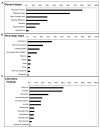Clinical and neurocognitive outcome in symptomatic isovaleric acidemia
- PMID: 22277694
- PMCID: PMC3292949
- DOI: 10.1186/1750-1172-7-9
Clinical and neurocognitive outcome in symptomatic isovaleric acidemia
Abstract
Background: Despite its first description over 40 years ago, knowledge of the clinical course of isovaleric acidemia (IVA), a disorder predisposing to severe acidotic episodes during catabolic stress, is still anecdotal. We aimed to investigate the phenotypic presentation and factors determining the neurological and neurocognitive outcomes of patients diagnosed with IVA following clinical manifestation.
Methods: Retrospective data on 21 children and adults with symptomatic IVA diagnosed from 1976 to 1999 were analyzed for outcome determinants including age at diagnosis and number of catabolic episodes. Sixteen of 21 patients were evaluated cross-sectionally focusing on the neurological and neurocognitive status. Additionally, 155 cases of patients with IVA published in the international literature were reviewed and analyzed for outcome parameters including mortality.
Results: 57% of study patients (12/21) were diagnosed within the first weeks of life and 43% (9/21) in childhood. An acute metabolic attack was the main cause of diagnostic work-up. 44% of investigated study patients (7/16) showed mild motor dysfunction and only 19% (3/16) had cognitive deficits. No other organ complications were found. The patients' intelligence quotient was not related to the number of catabolic episodes but was inversely related to age at diagnosis. In published cases, mortality was high (33%) if associated with neonatal diagnosis, following manifestation at an average age of 7 days.
Conclusions: Within the group of "classical" organic acidurias, IVA appears to be exceptional considering its milder neuropathologic implications. The potential to avoid neonatal mortality and to improve neurologic and cognitive outcome under early treatment reinforces IVA to be qualified for newborn screening.
Figures





Similar articles
-
Newborn screening and disease variants predict neurological outcome in isovaleric aciduria.J Inherit Metab Dis. 2021 Jul;44(4):857-870. doi: 10.1002/jimd.12364. Epub 2021 Feb 7. J Inherit Metab Dis. 2021. PMID: 33496032
-
Genotype and phenotype characterization in a Spanish cohort with isovaleric acidemia.J Hum Genet. 2017 Mar;62(3):355-360. doi: 10.1038/jhg.2016.144. Epub 2016 Dec 1. J Hum Genet. 2017. PMID: 27904153
-
Isovaleric acidemia. Clinical presentation of 6 cases.Turk J Pediatr. 1998 Jan-Mar;40(1):111-9. Turk J Pediatr. 1998. PMID: 9673537
-
'Classical' organic acidurias, propionic aciduria, methylmalonic aciduria and isovaleric aciduria: long-term outcome and effects of expanded newborn screening using tandem mass spectrometry.J Inherit Metab Dis. 2006 Apr-Jun;29(2-3):383-9. doi: 10.1007/s10545-006-0278-z. J Inherit Metab Dis. 2006. PMID: 16763906 Review.
-
Isovaleric acidemia: new aspects of genetic and phenotypic heterogeneity.Am J Med Genet C Semin Med Genet. 2006 May 15;142C(2):95-103. doi: 10.1002/ajmg.c.30089. Am J Med Genet C Semin Med Genet. 2006. PMID: 16602101 Free PMC article. Review.
Cited by
-
Acute Metabolic Decompensation of Isovaleric Acidemia Presenting as Persistent Metabolic Acidosis in a Middle-Aged Man: A Case Report.Cureus. 2024 Aug 19;16(8):e67253. doi: 10.7759/cureus.67253. eCollection 2024 Aug. Cureus. 2024. PMID: 39301405 Free PMC article.
-
Atypical MR lenticular signal change in infantile isovaleric acidemia.Indian J Radiol Imaging. 2016 Jan-Mar;26(1):131-4. doi: 10.4103/0971-3026.178362. Indian J Radiol Imaging. 2016. PMID: 27081237 Free PMC article.
-
Inborn errors of metabolism associated with hyperglycaemic ketoacidosis and diabetes mellitus: narrative review.Sudan J Paediatr. 2018;18(1):10-23. doi: 10.24911/SJP.2018.1.3. Sudan J Paediatr. 2018. PMID: 30166758 Free PMC article. Review.
-
Isovaleric acidemia: Therapeutic response to supplementation with glycine, l-carnitine, or both in combination and a 10-year follow-up case study.Mol Genet Metab Rep. 2017 Mar 17;11:2-5. doi: 10.1016/j.ymgmr.2017.03.002. eCollection 2017 Jun. Mol Genet Metab Rep. 2017. PMID: 30547004 Free PMC article.
-
Long-term neurological outcome of a cohort of 80 patients with classical organic acidurias.Orphanet J Rare Dis. 2013 Sep 23;8:148. doi: 10.1186/1750-1172-8-148. Orphanet J Rare Dis. 2013. PMID: 24059531 Free PMC article.
References
-
- Ensenauer R, Vockley J, Willard JM, Huey JC, Sass JO, Edland SD, Burton BK, Berry SA, Santer R, Grünert S. et al.A common mutation is associated with a mild, potentially asymptomatic phenotype in patients with isovaleric acidemia diagnosed by newborn screening. Am J Hum Genet. 2004;75:1136–1142. doi: 10.1086/426318. - DOI - PMC - PubMed
-
- Dionisi-Vici C, Deodato F, Röschinger W, Rhead W, Wilcken B. 'Classical' organic acidurias, propionic aciduria, methylmalonic aciduria and isovaleric aciduria: long-term outcome and effects of expanded newborn screening using tandem mass spectrometry. J Inherit Metab Dis. 2006;29:383–389. doi: 10.1007/s10545-006-0278-z. - DOI - PubMed
Publication types
MeSH terms
Substances
Supplementary concepts
LinkOut - more resources
Full Text Sources
Medical

